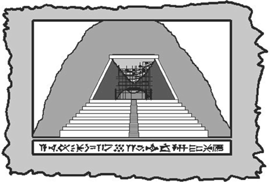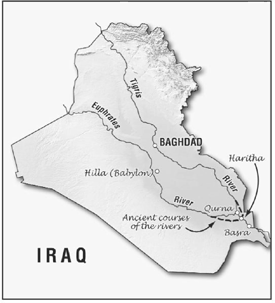Seven Ancient Wonders (36 page)
Read Seven Ancient Wonders Online
Authors: Matthew Reilly

The
Halicarnassus
shoomed through the night sky.
The big black unregistered 747 zoomed out of Africa on a flight-path that would take it across Saudi Arabia to one of harshest, wildest and most lawless countries on Earth.
Iraq.
It made one stop on the way.
An important stop in a remote corner of Saudi Arabia.
Hidden among some barren rocky hills was a cluster of small man-made caves, long-abandoned, with flapping rags covering their doorways. A long-disused firing range stood nearby, ravaged by dust and time; discarded ammunition boxes lay everywhere.
It was a former terrorist camp.
Once the home of Mustapha Zaeed—and the resting place of all his notes on the Seven Wonders of the Ancient World.
Covered by West, Stretch and Pooh Bear, the flex-cuffed Zaeed scrambled inside one particular cave where, behind a false wall, he located a large trunk filled with scrolls, tablets, sandstone bricks, gold and bronze ornaments, and literally
dozens
of notebooks.
It also contained within it a beautiful black-jade box no bigger than a shoebox. Before he passed the trunk out to the others, unseen by West’s men, Zaeed grabbed the black-jade box, opened
it, and gazed for a moment at the fine-grained orange sand inside it. It lay flat, undisturbed for many years. It was so fine it was almost luminous.
He snapped the jade box shut, slipped it back into the trunk, and passed it out to the others.
Then on the way out of the hidden space in the wall, he triggered a small electronic beacon.
Zaeed emerged from behind the false wall and presented the trunk to West. ‘My life’s work. It will help.’
‘It had better,’ West said.
They grabbed the trunk, hauled it back to the
Halicarnassus
, and resumed their course for Iraq.
Inside the
Halicarnassus
, West’s depleted team went about the task of finding the location of the Hanging Gardens of Babylon.
While West, Pooh Bear and Lily pored over Lily’s most recent translation of the Callimachus Text, Zaeed—his flex-cuffs now removed—was on his knees, rummaging through his dusty old trunk.
‘You know,’ Pooh Bear said, ‘it would be nice to have some idea what these Gardens actually looked like.’
West said, ‘Most drawings of the Gardens are little more than wild interpretations of vague Greek sources, most of them variations on the classic ziggurat shape. No-one has an actual image of them—’
‘Don’t speak too soon, Captain West! That may not be so! Here it is!’ Zaeed called, pulling a crude rectangle of very ancient cloth from his trunk.
It was about the size of an A4 sheet of paper, rough and rectangular. Its edges were worn, ragged, unsewn, like hessian cloth. Zaeed brought it over to the others.
‘It’s a draft cloth, a simple device used by ancient kings to keep an eye on the progress of their faraway construction sites. The cloth would be taken by a royal messenger to the worksite, where the
messenger then drew the scene. The messenger would then bring the cloth back to the king, thus showing him the progress being made.
‘I found this cloth in a pauper’s tomb underneath the town of Ash Shatra, in central Iraq—the tomb of a horseman who had died near the town, having been robbed and left for dead by bandits. Although he was buried as a pauper, I believe he was actually a royal messenger returning to New Babylon with a draft cloth of the Hanging Gardens for Nebuchadnezzar.
Behold
, all of you, the only picture, so far as I know, of the Hanging Gardens of Babylon:

‘It looks like an open cave in the mountainside,’ West said. ‘Only they refined the natural opening into a magnificent arch.’
‘What is that upside-down triangle suspended from the ceiling of the cave?’ Pooh Bear asked.
‘It looks like a gigantic
stalactite
. . . ’ Stretch said.
West said, ‘And that structure on the cave-floor directly beneath it appears to be a ziggurat, encased in a construction mud-mound. You used the mound to build the ziggurat and then you took the mound away after you were finished.’
Zaeed eyed West sideways. ‘If that is a full-sized ziggurat,
Captain, then that stalactite must be at least
fifteen storeys tall
. It must be immense.’
‘What are all those criss-crossing lines covering the two structures?’ Lily asked.
‘I have long pondered those lines, child,’ Zaeed said. ‘I believe that they are an ancient form of scaffolding—a multi-levelled temporary structure made of wooden poles used to build the Gardens. Remember, this cloth is a progress report—it depicts the Gardens being built. I therefore surmise that they are a building tool.’
Pooh Bear asked, ‘Lily. What does the writing say?’
Zaeed said, ‘My brother, this is not written in the language of Thoth. It’s just standard cuneiform, written by a messenger for his king—’
‘Lily can read cuneiform,’ West said. ‘Go on, Lily.’
Lily read the text box: ‘It says:
Progress report: Construction continuing as scheduled. Nineteen worker deaths. Sixty-two injuries. Losses tolerable.
’
‘Losses tolerable,’ Stretch repeated. ‘Doesn’t look like the despots of this region have changed much over the ages.’
They returned to Lily’s translation of the Callimachus Text’s sixth entry:
The Hanging Paradise of Old Babylonia.
March towards the rising Sun,
From the point where the two life-givers become one.
In the shadow of the mountains of Zagros,
Behold the triple falls fashioned by the Third Great Architect
To conceal the path he hewed
That climbs to the Paradise
Which mighty Nebuchadnezzar built for his bride
.
‘Well, it begins straightforwardly enough,’ West said. ‘You march due east from the point where the two life-givers become
one.“The life-givers” is the name the Mesopotamians gave to the Tigris and Euphrates rivers. This must be a reference to the point where they meet.’
‘Baghdad?’ Pooh Bear asked. ‘It stands at a point of convergence of the Tigris and Euphrates. Isn’t it the site of ancient Babylon?’
‘Actually, no,’ West said. ‘Babylon lies underneath the modern-day town of Hilla, to the south of Baghdad. And your theory doesn’t strictly obey the verse. The two rivers bend very close to each other at Baghdad, but they don’t
become one
there. They actually come together much further south, at the town of Qurna. There they become one big super-river—the Shatt al-Arab—which flows south through Basra before draining into the Persian Gulf.’
Stretch said sourly: ‘I can’t believe the Americans haven’t found the Gardens already. They must have over 150,000 troops in Iraq right now. They could easily have sent huge forces of men to check out every waterfall in the Zagros Mountains due east of Baghdad, Hilla
and
Qurna by now.’
West paused, an idea forming in his mind. ‘Unless. . . ’
‘What?’
‘The modern town of Hilla does indeed stand on the ruins of Nebuchadnezzar’s Babylon,’ he said. ‘But now that I look at it closely, our verse does not refer to “Babylon” at all. It mentions the Hanging Paradise of
Old Babylonia
. Old Babylon.’
‘Meaning?’ Pooh Bear asked.
‘Consider this,’ West said. ‘New York. New England. New Orleans. Today, many cities and regions are named in memory of older places. In some ancient texts, Nebuchadnezzar’s Babylon is actually referred to as
New
Babylon. What if the Gardens were
never
in New Babylon, but were, rather, built in an older city also named “Babylon”, but built far from the newer city that adopted its name. The
original
Babylon.’
‘It would explain why Alexander the Great’s biographers never mentioned the Gardens when he passed through Babylon and why no-one has found them near Hilla,’ Stretch said. ‘They would only have seen New Babylon, not Old Babylon.’
‘Two Babylons. Two cities.’ Zaeed stroked his sharply-pointed chin. ‘This is a good theory. . . ’
Then suddenly his eyes lit up. ‘Of course!
Of course!
Why didn’t I think of it before?’
‘What?’
Zaeed dashed to his trunk and scrounged among the notebooks there.
As he did so, he spoke quickly, excitedly. ‘If I may take Captain West’s theory one step further. Modern logic assumes that the Tigris and the Euphrates follow the
same
courses today that they followed back in 570 BC. They flow down from Turkey, through Iraq, before joining at Qurna in the southern marshlands.
‘Now consider this. Mesopotamia is the birthplace of all flood myths. Why, the tale of Noah and his Ark is but a flimsy retelling of the story of Zisudra and his animal-carrying boat. Why is this so? Because Iraq’s flood myths stem from
very real
floods: of the Persian Gulf breaking its banks and flooding far inland, ripping apart eroded land formations and, on occasion,
diverting
the courses of the two great rivers of the region, the Tigris and Euphrates. A Westerner named Graham Hancock has written about this very convincingly in a marvellous book called
Underworld
. Ah-ha! Here it is!’
He produced a battered book, opened it to a page containing a map of Iraq. Prominent on the map were the two major rivers, the Tigris and Euphrates, that joined in a V shape in the south of the country:

Zaeed had scribbled the locations of Hilla, Qurna and Basra on the map.
He explained. ‘Now. As we continue to do today, people back in ancient times built their towns on the banks of the two great rivers. But when the rivers diverted onto new courses due to flooding, it follows that those same people would have abandoned the old towns and built new ones, the ones we see on the banks of the rivers today.
‘Many years ago, in my search for lost documents relating to the Hanging Gardens, I mapped the locations of
abandoned
towns, towns that were once situated on the banks of the rivers, but which, once the rivers diverted, were simply deserted. From these locations, I was able to reconstruct the
former
courses of the two rivers.’
‘So where did they converge back then?’ West asked.
Zaeed grinned. ‘See,
that
was what I did not know—that their
point of convergence
was the all-important factor.’
With a flourish, Zaeed then flipped the page to reveal a
second
map of Iraq, only on this map, an additional dotted V had been drawn directly beneath the present-day one:

Zaeed pointed at this new river junction—it lay south of Qurna, roughly halfway between it and Basra.
‘The rivers,’ Zaeed said, ‘used to meet here, at the town of Haritha.’
The
Halicarnassus
shot into Iraq, heading for the southern village-town of Haritha.
As it did so, everyone prepared for their arrival—prepping guns, maps, helmets and tunnel gear.
Alone in his office, with Horus perched on his chair-back, West kept one eye on a laptop computer that Wizard had set up soon after their mission in Tunisia had gone to hell.
It was the microwave communications net he had instructed Wizard to create, to scan for any signals emanating from, or coming to, the
Halicarnassus
.
